The Old World flycatcher family Muscicapidae is a large family of small passerine birds mostly restricted to the Old World. The family comprises 18 genera, 117 species, 317 taxa. These are mainly small arboreal insectivores, many of which, as the name implies, take their prey on the wing. Recently, several species of "chats and allies" of the subfamily Saxicolinae were formerly classified in the Family Turdidae and are now included in the Muscicapidae. Similar behaviours and genetic studies are the main causes of this new taxonomy. They belong to the Old World species, and are distributed in Europe, Africa and Asia. Some species are called Scrub Robins, Robin Chats, Flycatchers, Rock Thrushes, Robins, Chats, Stonechats and Wheatears.
The birds of this family are rather small with species ranging from 10 to 22 cm long, and 4/8 to 25/42 grams in weight. They have short bill with wide base and and flattened dorsoventrally, wide gape and well-developed rictal bristles, small and rather weak legs and feet, short to medium-length tail; plumage often dull, predominantly grey or brown, males in some genera brightly coloured. Wings are more or less long and pointed, according to the migratory behaviour of each bird, and its feeding habits.
They are found in forest, woodland, savanna and scrub.
Depending on the species, their nests are either well-constructed cups placed in a tree or cliff ledge, or simply lining in a pre-existing tree hole. The hole-nesting species tend to lay larger clutches, with an average of eight eggs, rather than just two to five.
Some flyctachers in the genus Melaenornis are sometimes placed in the genus Bradornis. However, according to other authorities (Dickinson 2003, Sangster et al 2010), the genus Melaenornis includes Dioptrornis, Bradornis, Sigelus.
Links:
Trevor Carnaby: Beat about the Bush: Birds
Africa Wild Bird Book
Family Muscicapidae (Chats, Old World Flycatchers) Index
Family Muscicapidae (Chats, Old World Flycatchers)
Cercotrichas coryphoeus Karoo Scrub Robin 614
Cercotrichas quadrivirgata Bearded Scrub Robin 617
Cercotrichas paena Kalahari Scrub Robin 615
Cercotrichas leucophrys White-browed Scrub Robin 613
Cercotrichas signata Brown Scrub Robin 616
Myioparus plumbeus Grey Tit-Flycatcher 693
Melaenornis pammelaina Southern Black Flycatcher 694
Melaenornis pallidus Pale Flycatcher 696
Melaenornis infuscatus Chat Flycatcher 697
Melaenornis mariquensis Marico Flycatcher 695
Melaenornis silens Fiscal Flycatcher 698
Muscicapa caerulescens Ashy Flycatcher 691
Muscicapa adusta African Dusky Flycatcher 690
Muscicapa striata Spotted Flycatcher 689
Pseudalethe fuelleborni White-chested Alethe 605
Cossypha anomala Olive-flanked Ground Robin
Cossypha caffra Cape Robin-Chat 601
Cossypha humeralis White-throated Robin-Chat 602
Cossypha heuglini White-browed Robin-Chat 599
Cossypha natalensis Red-capped Robin-Chat 600
Cossypha dichroa Chorister Robin-Chat 598
Swynnertonia swynnertoni Swynnerton's Robin 607
Pogonocichla stellata White-starred Robin 606
Sheppardia gunningi East Coast Akalat 608
Phoenicurus phoenicurus Common Redstart 916
Monticola rupestris Cape Rock Thrush 581
Monticola explorator Sentinel Rock Thrush 582
Monticola brevipes Short-toed Rock Thrush 583
Monticola angolensis Miombo Rock Thrush 584
Saxicola rubetra Whinchat 597
Saxicola torquatus African Stonechat 596
Campicoloides bifasciatus Buff-streaked Chat 588
Emarginata sinuata Sickle-winged Chat 591
Emarginata schlegelii Karoo Chat 592
Emarginata tractrac Tractrac Chat 590
Thamnolaea cinnamomeiventris Mocking Cliff Chat 593
Myrmecocichla formicivora Ant-eating Chat 595
Myrmecocichla monticola Mountain Wheatear 586
Myrmecocichla arnotti Arnot's Chat 594
Oenanthe oenanthe Northern Wheatear (European Wheatear) 585
Oenanthe pileata Capped Wheatear 587
Oenanthe isabellina Isabelline Wheatear 915
Oenanthe pleschanka Pied Wheatear 907
Oenanthe familiaris Familiar Chat 589
Cichladusa arquata Collared Palm-Thrush 603
Pinarornis plumosus Boulder Chat 610
Namibornis herero Herero Chat 618
Cercotrichas coryphoeus Karoo Scrub Robin 614
Cercotrichas quadrivirgata Bearded Scrub Robin 617
Cercotrichas paena Kalahari Scrub Robin 615
Cercotrichas leucophrys White-browed Scrub Robin 613
Cercotrichas signata Brown Scrub Robin 616
Myioparus plumbeus Grey Tit-Flycatcher 693
Melaenornis pammelaina Southern Black Flycatcher 694
Melaenornis pallidus Pale Flycatcher 696
Melaenornis infuscatus Chat Flycatcher 697
Melaenornis mariquensis Marico Flycatcher 695
Melaenornis silens Fiscal Flycatcher 698
Muscicapa caerulescens Ashy Flycatcher 691
Muscicapa adusta African Dusky Flycatcher 690
Muscicapa striata Spotted Flycatcher 689
Pseudalethe fuelleborni White-chested Alethe 605
Cossypha anomala Olive-flanked Ground Robin
Cossypha caffra Cape Robin-Chat 601
Cossypha humeralis White-throated Robin-Chat 602
Cossypha heuglini White-browed Robin-Chat 599
Cossypha natalensis Red-capped Robin-Chat 600
Cossypha dichroa Chorister Robin-Chat 598
Swynnertonia swynnertoni Swynnerton's Robin 607
Pogonocichla stellata White-starred Robin 606
Sheppardia gunningi East Coast Akalat 608
Phoenicurus phoenicurus Common Redstart 916
Monticola rupestris Cape Rock Thrush 581
Monticola explorator Sentinel Rock Thrush 582
Monticola brevipes Short-toed Rock Thrush 583
Monticola angolensis Miombo Rock Thrush 584
Saxicola rubetra Whinchat 597
Saxicola torquatus African Stonechat 596
Campicoloides bifasciatus Buff-streaked Chat 588
Emarginata sinuata Sickle-winged Chat 591
Emarginata schlegelii Karoo Chat 592
Emarginata tractrac Tractrac Chat 590
Thamnolaea cinnamomeiventris Mocking Cliff Chat 593
Myrmecocichla formicivora Ant-eating Chat 595
Myrmecocichla monticola Mountain Wheatear 586
Myrmecocichla arnotti Arnot's Chat 594
Oenanthe oenanthe Northern Wheatear (European Wheatear) 585
Oenanthe pileata Capped Wheatear 587
Oenanthe isabellina Isabelline Wheatear 915
Oenanthe pleschanka Pied Wheatear 907
Oenanthe familiaris Familiar Chat 589
Cichladusa arquata Collared Palm-Thrush 603
Pinarornis plumosus Boulder Chat 610
Namibornis herero Herero Chat 618
- Flutterby
- Posts: 44029
- Joined: Sat May 19, 2012 12:28 pm
- Country: South Africa
- Location: Gauteng, South Africa
- Contact:
Karoo Scrub-robin
614. Karoo Scrub-robin (formerly known as Karoo Robin) Cercotrichas coryphoeus (Slangverklikker)
Order: Passeriformes. Family: Muscicapidae
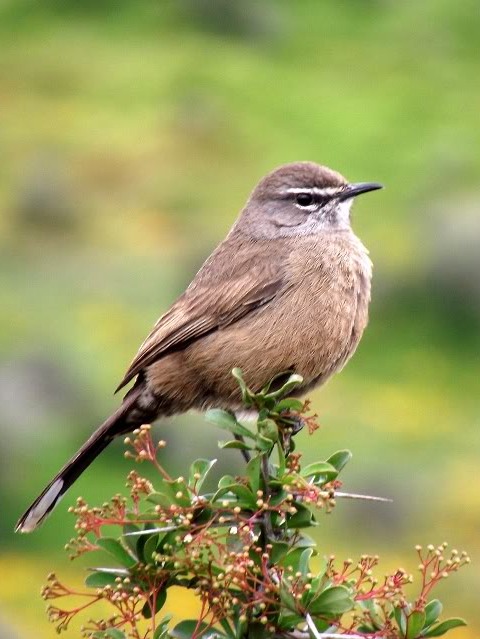 © Ronnie
© Ronnie
Description
Length 17 cm, weight 18-23 g. A dull grey-brown scrub-robin with a white-tipped black tail. Striking facial pattern; white partial eyering, eyebrow, moustachial stripe and throat contrast with black-edged brown crown, black eyestripe and grey malar stripe.
Juvenile is sooty brown, mottled with buff; the eyebrow is distinct.
Similar species: This species lacks the breast streaking of White-browed Scrub-Robin; it is much darker than Kalahari Scrub-Robin and lacks rufous in the tail.
Distribution
Endemic to southern Africa, occurring from southern Namibia to much of the Northern, Western and Eastern Cape, extending into the Free State, Lesotho and the North-West Province.

Habitat
Dry scrub with patches of bare ground, such as renosterveld, Karoo shrubland, fynbos, bushveld and drainage line woodland dominated by either Sweet thorn (Acacia karroo) or Wild tamarisk (Tamarix usneoides).
Diet
It forages on the ground for invertebrates, mainly ants, termites and beetles. Also eats small fruit.
Breeding
Monogamous and territorial; a cooperative breeder, as the roughly 10 week juveniles help their parents with rearing the next brood. The nest is an open cup of twigs, lined with fine plant material and animal fur. The female often builds it by herself, but the male and group members often feed her and help collect nesting material. It is typically placed at the base or in the foliage of a small shrub. Egg-laying season is from July-December, peaking around October. It lays 2-4 eggs, which are incubated solely by the female for about 13-15 days, while the male regularly feeds her. The chicks are fed by both adults and sometimes their helpers, leaving the nest after about 13-17 days. They typically remain in the nest bush for a 1 or 2 more days before taking off, becoming fully independent after about 4 more weeks, but sometimes remaining with the parents to help with next brood.
Rarely parasitised by Dideric Cuckoo.
Call
A harsh, chittering tchik, tchik, tcheet; song a mixture of whistles and grating notes. Listen to Bird Call.
Order: Passeriformes. Family: Muscicapidae
 © Ronnie
© RonnieDescription
Length 17 cm, weight 18-23 g. A dull grey-brown scrub-robin with a white-tipped black tail. Striking facial pattern; white partial eyering, eyebrow, moustachial stripe and throat contrast with black-edged brown crown, black eyestripe and grey malar stripe.
Juvenile is sooty brown, mottled with buff; the eyebrow is distinct.
Similar species: This species lacks the breast streaking of White-browed Scrub-Robin; it is much darker than Kalahari Scrub-Robin and lacks rufous in the tail.
Distribution
Endemic to southern Africa, occurring from southern Namibia to much of the Northern, Western and Eastern Cape, extending into the Free State, Lesotho and the North-West Province.

Habitat
Dry scrub with patches of bare ground, such as renosterveld, Karoo shrubland, fynbos, bushveld and drainage line woodland dominated by either Sweet thorn (Acacia karroo) or Wild tamarisk (Tamarix usneoides).
Diet
It forages on the ground for invertebrates, mainly ants, termites and beetles. Also eats small fruit.
Breeding
Monogamous and territorial; a cooperative breeder, as the roughly 10 week juveniles help their parents with rearing the next brood. The nest is an open cup of twigs, lined with fine plant material and animal fur. The female often builds it by herself, but the male and group members often feed her and help collect nesting material. It is typically placed at the base or in the foliage of a small shrub. Egg-laying season is from July-December, peaking around October. It lays 2-4 eggs, which are incubated solely by the female for about 13-15 days, while the male regularly feeds her. The chicks are fed by both adults and sometimes their helpers, leaving the nest after about 13-17 days. They typically remain in the nest bush for a 1 or 2 more days before taking off, becoming fully independent after about 4 more weeks, but sometimes remaining with the parents to help with next brood.
Rarely parasitised by Dideric Cuckoo.
Call
A harsh, chittering tchik, tchik, tcheet; song a mixture of whistles and grating notes. Listen to Bird Call.
- Flutterby
- Posts: 44029
- Joined: Sat May 19, 2012 12:28 pm
- Country: South Africa
- Location: Gauteng, South Africa
- Contact:
Karoo Scrub-robin Photos
614. Karoo Scrub-robin Cercotrichas coryphoeus
Camdeboo National Park © Peter Betts
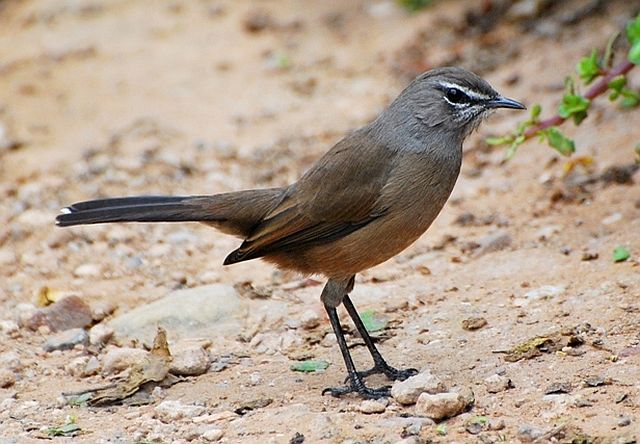 © Mel
© Mel
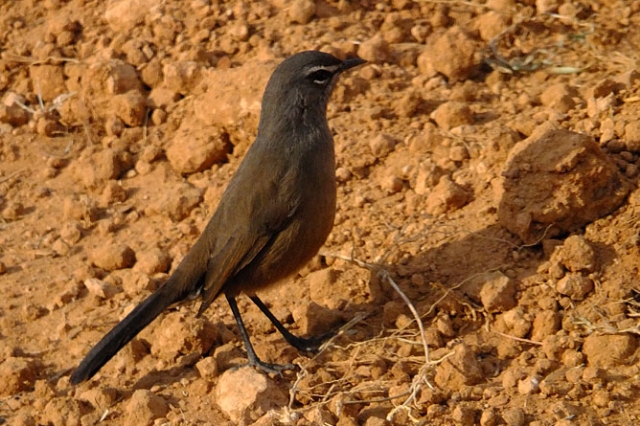 © PJL
© PJL
Addo Elephant National Park
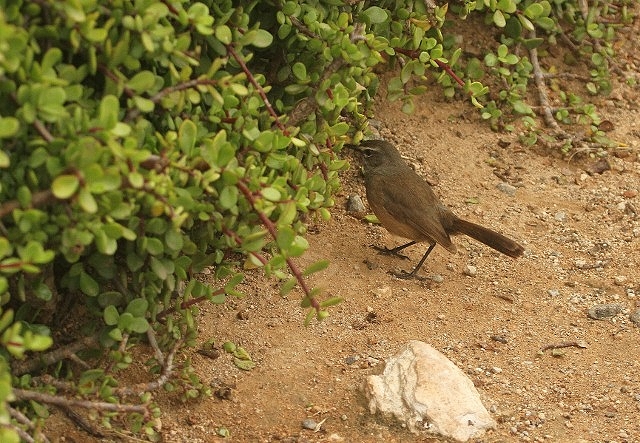 © nan
© nan
Addo Elephant National Park
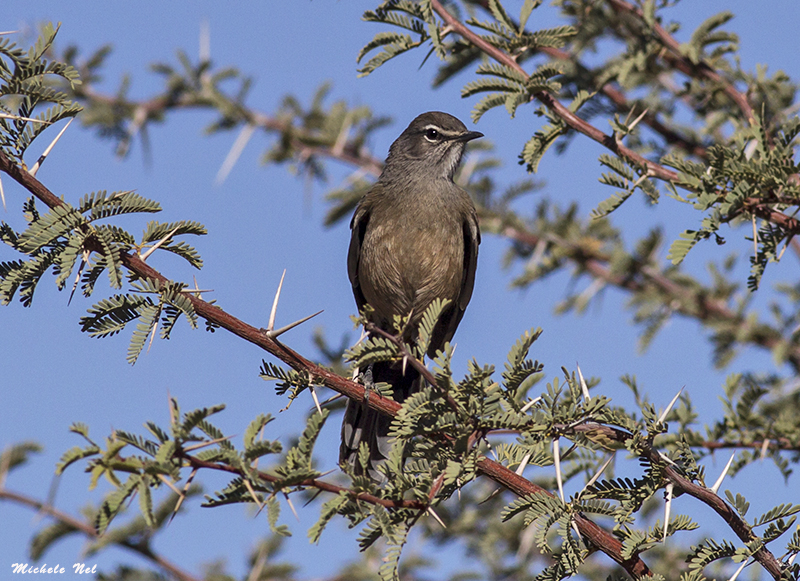 © Michele Nel
© Michele Nel
Kgalagadi Transfrontier Park, Twee Rivieren 23/07/2016
Links:
sabap2: http://sabap2.adu.org.za/species_info.p ... #menu_left
Ian Sinclair, P. A. R. Hockey. The Larger Illustrated Guide to Birds of Southern Africa
Camdeboo National Park © Peter Betts
 © Mel
© Mel  © PJL
© PJLAddo Elephant National Park
 © nan
© nanAddo Elephant National Park
 © Michele Nel
© Michele NelKgalagadi Transfrontier Park, Twee Rivieren 23/07/2016
Links:
sabap2: http://sabap2.adu.org.za/species_info.p ... #menu_left
Ian Sinclair, P. A. R. Hockey. The Larger Illustrated Guide to Birds of Southern Africa
Bearded Scrub-robin
617. Bearded Scrub-robin Cercotrichas quadrivirgata (Baardwipstert)
Order: Passeriformes. Family: Muscicapidae
Description
Length 17 cm, mass 21-31 g. This Scrub Robin has a distinctive head-pattern: Olive-brown crown and ear coverts; black stripe above broad white supercilium and greyish and blackish crown-, eye- and malar-stripes.
Adult: Bold facial pattern comprises white supercilium and moustachial stripe, white crescent beneath eye, and blackish lateral crown stripes, eye stripes and malar stripes. Upperparts olive-brown, shading across rump to rufous upper tail coverts. Throat white. Breast and flanks buffy rufous to cinnamon; belly and undertail coverts white. Bill black. Eyes brown. Legs and feet flesh.
Distribution
It occurs from southern Somalia through eastern Tanzania to Malawi, Zambia and southern Africa. Here it is locally common in Zimbabwe, Mozambique, northern Botswana, Caprivi Strip (Namibia) and the extreme east of South Africa.
Habitat
Thornveld, Thickets & broad-leaved woodland. It generally prefers sand forest, thickets in broad-leaved woodland or savanna and riverine forest.
Diet
Invertebrates. It mainly eats beetles and ants, doing most of its foraging on the ground, often taking prey flushed by driver ant swarms. It may also forage high up in the tree canopy, gleaning ants and caterpillars from leaves and branches.
Breeding
Monogamous. The nest is an open cup set into a pad of rootlets and dead leaves, sometimes also including lichen, dried grass, small twigs and moss, lined with animal hair such as that of the Nyala, Bushpig and Red Duiker. It is typically placed in a rotten cavity in a living tree, on top of a hollow stump or in a hole at the base of a fork against the tree trunk. Egg-laying season is from September-December. It lays 2-3 eggs, which are incubated solely by the female for about 11-14 days. The chicks are fed by both adults, leaving the nest after about 15-17 days, after which they still remain dependent on their parents for about 4 more weeks.
Occasionally parasitised by Red-chested Cuckoo.
Call
Fine songster; series of loud melodious whistled phrases. Listen to Bird Call.
Status
Common resident in suitable habitat.
Order: Passeriformes. Family: Muscicapidae
Description
Length 17 cm, mass 21-31 g. This Scrub Robin has a distinctive head-pattern: Olive-brown crown and ear coverts; black stripe above broad white supercilium and greyish and blackish crown-, eye- and malar-stripes.
Adult: Bold facial pattern comprises white supercilium and moustachial stripe, white crescent beneath eye, and blackish lateral crown stripes, eye stripes and malar stripes. Upperparts olive-brown, shading across rump to rufous upper tail coverts. Throat white. Breast and flanks buffy rufous to cinnamon; belly and undertail coverts white. Bill black. Eyes brown. Legs and feet flesh.
Distribution
It occurs from southern Somalia through eastern Tanzania to Malawi, Zambia and southern Africa. Here it is locally common in Zimbabwe, Mozambique, northern Botswana, Caprivi Strip (Namibia) and the extreme east of South Africa.
Habitat
Thornveld, Thickets & broad-leaved woodland. It generally prefers sand forest, thickets in broad-leaved woodland or savanna and riverine forest.
Diet
Invertebrates. It mainly eats beetles and ants, doing most of its foraging on the ground, often taking prey flushed by driver ant swarms. It may also forage high up in the tree canopy, gleaning ants and caterpillars from leaves and branches.
Breeding
Monogamous. The nest is an open cup set into a pad of rootlets and dead leaves, sometimes also including lichen, dried grass, small twigs and moss, lined with animal hair such as that of the Nyala, Bushpig and Red Duiker. It is typically placed in a rotten cavity in a living tree, on top of a hollow stump or in a hole at the base of a fork against the tree trunk. Egg-laying season is from September-December. It lays 2-3 eggs, which are incubated solely by the female for about 11-14 days. The chicks are fed by both adults, leaving the nest after about 15-17 days, after which they still remain dependent on their parents for about 4 more weeks.
Occasionally parasitised by Red-chested Cuckoo.
Call
Fine songster; series of loud melodious whistled phrases. Listen to Bird Call.
Status
Common resident in suitable habitat.
Dewi
What is the good of having a nice house without a decent planet to put it on? (H D Thoreau)
What is the good of having a nice house without a decent planet to put it on? (H D Thoreau)
Bearded Scrub-robin Photos
617. Bearded Scrub-robin Cercotrichas quadrivirgata
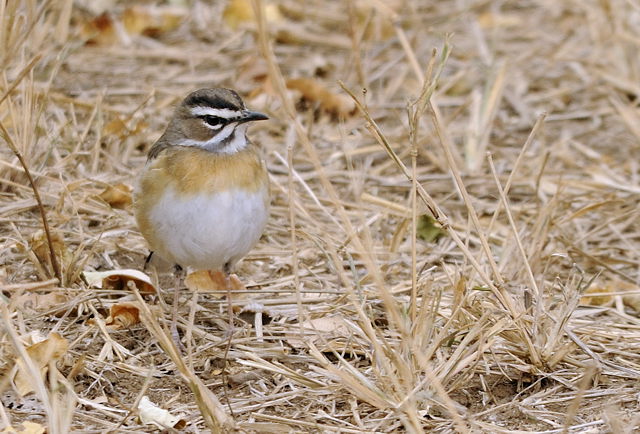 © Dewi
© Dewi
Punda Maria Camp, Kruger National Park
 © Dewi
© Dewi
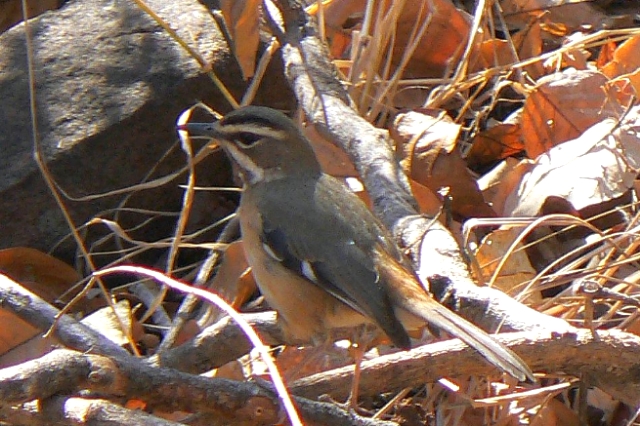 © Toko
© Toko
Punda Maria, Kruger National Park
Links:
Species text Sabap1
Sabap2
Birds of Botswana
Ian Sinclair,P. A. R. Hockey. The Larger Illustrated Guide to Birds of Southern Africa
 © Dewi
© DewiPunda Maria Camp, Kruger National Park
 © Dewi
© Dewi © Toko
© TokoPunda Maria, Kruger National Park
Links:
Species text Sabap1
Sabap2
Birds of Botswana
Ian Sinclair,P. A. R. Hockey. The Larger Illustrated Guide to Birds of Southern Africa
Dewi
What is the good of having a nice house without a decent planet to put it on? (H D Thoreau)
What is the good of having a nice house without a decent planet to put it on? (H D Thoreau)
- Mel
- Global Moderator
- Posts: 26737
- Joined: Sat May 19, 2012 12:31 pm
- Country: Germany
- Location: Föhr
- Contact:
Kalahari Scrub-robin
615. Kalahari Scrub-robin Cercotrichas paena (Kalahariwipstert)
Order: Passeriformes. Family: Muscicapidae
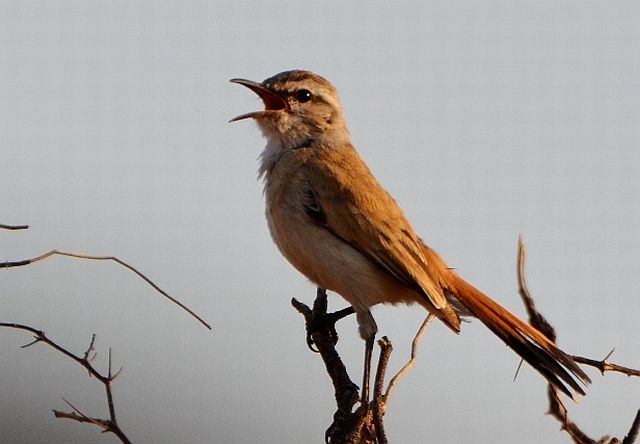 © Mel
© Mel
Kgalagadi Transfrontier Park
Description
Sandy-coloured with plain, pale underparts. The rufous colour of the rump extends onto the tail. Tail has a broad black bar above a white tip. In flight, the fanned tail is orange with a broad, black subterminal band and prominent white tips to the feathers.
Juvenile is mottled with sooty black and buff above and below; tail like adult.
Similar species: It lacks the breast streaks and white wing bar of White-browed Scrub Robin and in flight shows more rufous on the tail. The White-browed Scrub Robin has a streaked breast and the white edging to the upperwing coverts forming two white wing bars. The Karoo Scrub Robin, which is found together with the Kalahari Scrub Robin in parts of the northern Cape Province and central Free State, has no orange coloration in its tail.
Distribution
Near-endemic to southern Africa, occurring from South-West Angola through Namibia to Botswana, north-central South Africa and Zimbabwe. Its stronghold is centred on the Kalahari basin in Botswana, it extends to the west and northwest into Namibia and Angola, to the south into the northern Cape Province and the Free State, and to the east into Limpopo and the dry southwestern parts of Zimbabwe.
Habitat
Generally prefers arid and semi-arid areas with scattered trees, bushes and patches of bare ground such as sandveld, scrub and wooded savanna.
Diet
It mainly eats insects, especially ants, beetles and termites, doing most of its of its foraging on bare ground.
Breeding
The nest is a compact cup set into a messy structure of dry grass, leaves and occasionally twigs, the interior lined with finer material such as tendrils, rootlets and animal hair. It is typically placed close to, but not on the ground in a shrub, or occasionally in a man-made objects such as a tin. In moister regions egg-laying season is from July-January, peaking during October, but in more arid areas it can breed at any time of year in response to rainfall. It lays 2-4 eggs, which are incubated solely by the female for 13 days.
Call
Alarm notes a harsh zzeee; contact call a whistled seeeup; a musical song of whistles and chirps.
Status
Common, near endemic resident.
Order: Passeriformes. Family: Muscicapidae
 © Mel
© MelKgalagadi Transfrontier Park
Description
Sandy-coloured with plain, pale underparts. The rufous colour of the rump extends onto the tail. Tail has a broad black bar above a white tip. In flight, the fanned tail is orange with a broad, black subterminal band and prominent white tips to the feathers.
Juvenile is mottled with sooty black and buff above and below; tail like adult.
Similar species: It lacks the breast streaks and white wing bar of White-browed Scrub Robin and in flight shows more rufous on the tail. The White-browed Scrub Robin has a streaked breast and the white edging to the upperwing coverts forming two white wing bars. The Karoo Scrub Robin, which is found together with the Kalahari Scrub Robin in parts of the northern Cape Province and central Free State, has no orange coloration in its tail.
Distribution
Near-endemic to southern Africa, occurring from South-West Angola through Namibia to Botswana, north-central South Africa and Zimbabwe. Its stronghold is centred on the Kalahari basin in Botswana, it extends to the west and northwest into Namibia and Angola, to the south into the northern Cape Province and the Free State, and to the east into Limpopo and the dry southwestern parts of Zimbabwe.
Habitat
Generally prefers arid and semi-arid areas with scattered trees, bushes and patches of bare ground such as sandveld, scrub and wooded savanna.
Diet
It mainly eats insects, especially ants, beetles and termites, doing most of its of its foraging on bare ground.
Breeding
The nest is a compact cup set into a messy structure of dry grass, leaves and occasionally twigs, the interior lined with finer material such as tendrils, rootlets and animal hair. It is typically placed close to, but not on the ground in a shrub, or occasionally in a man-made objects such as a tin. In moister regions egg-laying season is from July-January, peaking during October, but in more arid areas it can breed at any time of year in response to rainfall. It lays 2-4 eggs, which are incubated solely by the female for 13 days.
Call
Alarm notes a harsh zzeee; contact call a whistled seeeup; a musical song of whistles and chirps.
Status
Common, near endemic resident.
God put me on earth to accomplish a certain amount of things. Right now I'm so far behind that I'll never die.
- Mel
- Global Moderator
- Posts: 26737
- Joined: Sat May 19, 2012 12:31 pm
- Country: Germany
- Location: Föhr
- Contact:
Kalahari Scrub-robin Photos
615. Kalahari Scrub-robin Cercotrichas paena (Kalahariwipstert)
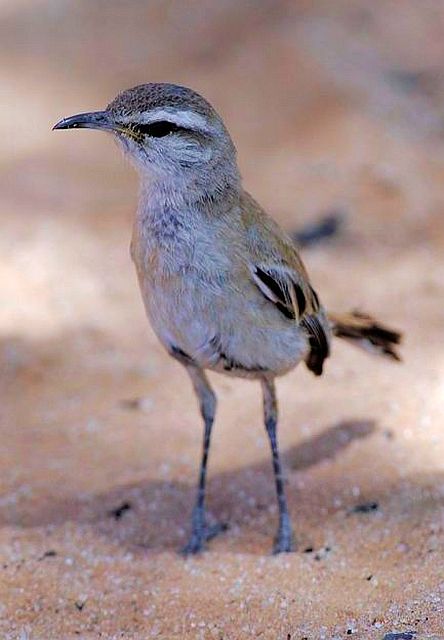 © Dewi
© Dewi
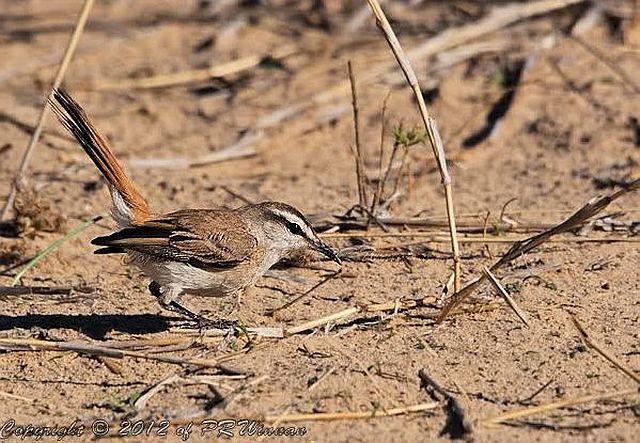 © PRWIN
© PRWIN
 © Toko
© Toko
Kgalagadi Transfrontier Park
Links:
http://sabap2.adu.org.za/docs/sabap1/615.pdf
http://sabap2.adu.org.za/spp_summary.ph ... §ion=3
Birds of Botswana
Ian Sinclair,P. A. R. Hockey. The Larger Illustrated Guide to Birds of Southern Africa
 © Dewi
© Dewi © PRWIN
© PRWIN © Toko
© TokoKgalagadi Transfrontier Park
Links:
http://sabap2.adu.org.za/docs/sabap1/615.pdf
http://sabap2.adu.org.za/spp_summary.ph ... §ion=3
Birds of Botswana
Ian Sinclair,P. A. R. Hockey. The Larger Illustrated Guide to Birds of Southern Africa
God put me on earth to accomplish a certain amount of things. Right now I'm so far behind that I'll never die.
- Flutterby
- Posts: 44029
- Joined: Sat May 19, 2012 12:28 pm
- Country: South Africa
- Location: Gauteng, South Africa
- Contact:
White-browed Scrub-robin
613. White-browed Scrub-robin Cercotrichas leucophrys, Erythropygia leucophrys (Gestreepte Wipstert)
Order: Passeriformes. Family: Muscicapidae
Description
15 cm.
Adult: Upperparts are light brown with faint streaking; the rump is orange-rufous and the blackish tail has a white tip; white wing bars; underparts are white with darl brown streaks on the breast and flanks (but North-western race C. l. ovamboensis largely unstreaked.). It has a white eyebrow, and also black moustachial stripes. The bill is black with a yellowish pink base.; eyes are brown; legs and feet are pink. Sexes alike.
The juvenile is mottled above eye-stripe, wingbars buffy, has buff and dark brown spots on both upper- and under-parts (not streaked).
Similar species: It resembles Kalahari Scrub Robin but differs in having a heavily streaked breast, and white bars on the wing coverts. Kalahari Scrub-Robin has an orange tail with a black subterminal band (also tipped white) and is unstreaked below.
Distribution
The White-browed Scrub-robin is found through most of Africa from Gabon to Somalia south through Tanzania, southern DRC and Angola to southern Africa. Here it is common across the the eastern half of South Africa through to Zimbabwe, Mozambique, Botswana and northern Namibia.
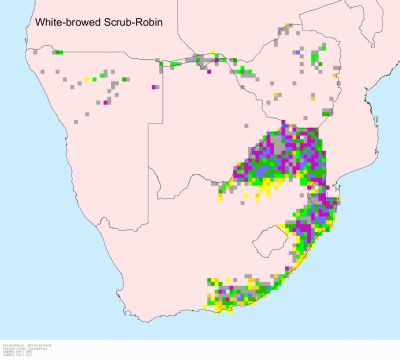
Habitat
Woodland and savanna, especially where acacias are found.
Diet
White-browed Scrub-robins feed mainly on the ground where they typically run forward a short distance and then stop with an upwards tilt of the tail. They eat mostly invertebrates such as termites, beetles and caterpillars, crickets and grasshoppers.
Breeding
White-browed Scrub Robins are monogamous and the pairs remain together in their territory, which they defend vigorously, throughout the year. The nest is built solely by the female in about 4-5 days, consisting of a deep, untidy open cup built mainly of dry grass, sometimes with a few twigs, dead Acacia leaves incorporated into the structure. A lining of grass roots, flowerheads and leaves is also sometimes added. It is typically placed in the center of a grass tuft at the base of a tree, on the dead leaves of an aloe or in climbing grass tussocks on fallen branches. Egg-laying season is from September-January, peaking from September-November. It lays 2-4 white eggs, which are incubated solely by the female. The chicks are frequently brooded by the female during the first few days of their lives and are fed by both parents, leaving the nest after about 11-12 days.
Occasionally parasitised by Diderick and Red-chested Cuckoos.
Call
Their call is a melodious pee boo goo, usually made from a conspicuous perch. Listen to Bird Call.
Status
Very common resident, usually in pairs.
Order: Passeriformes. Family: Muscicapidae
Description
15 cm.
Adult: Upperparts are light brown with faint streaking; the rump is orange-rufous and the blackish tail has a white tip; white wing bars; underparts are white with darl brown streaks on the breast and flanks (but North-western race C. l. ovamboensis largely unstreaked.). It has a white eyebrow, and also black moustachial stripes. The bill is black with a yellowish pink base.; eyes are brown; legs and feet are pink. Sexes alike.
The juvenile is mottled above eye-stripe, wingbars buffy, has buff and dark brown spots on both upper- and under-parts (not streaked).
Similar species: It resembles Kalahari Scrub Robin but differs in having a heavily streaked breast, and white bars on the wing coverts. Kalahari Scrub-Robin has an orange tail with a black subterminal band (also tipped white) and is unstreaked below.
Distribution
The White-browed Scrub-robin is found through most of Africa from Gabon to Somalia south through Tanzania, southern DRC and Angola to southern Africa. Here it is common across the the eastern half of South Africa through to Zimbabwe, Mozambique, Botswana and northern Namibia.

Habitat
Woodland and savanna, especially where acacias are found.
Diet
White-browed Scrub-robins feed mainly on the ground where they typically run forward a short distance and then stop with an upwards tilt of the tail. They eat mostly invertebrates such as termites, beetles and caterpillars, crickets and grasshoppers.
Breeding
White-browed Scrub Robins are monogamous and the pairs remain together in their territory, which they defend vigorously, throughout the year. The nest is built solely by the female in about 4-5 days, consisting of a deep, untidy open cup built mainly of dry grass, sometimes with a few twigs, dead Acacia leaves incorporated into the structure. A lining of grass roots, flowerheads and leaves is also sometimes added. It is typically placed in the center of a grass tuft at the base of a tree, on the dead leaves of an aloe or in climbing grass tussocks on fallen branches. Egg-laying season is from September-January, peaking from September-November. It lays 2-4 white eggs, which are incubated solely by the female. The chicks are frequently brooded by the female during the first few days of their lives and are fed by both parents, leaving the nest after about 11-12 days.
Occasionally parasitised by Diderick and Red-chested Cuckoos.
Call
Their call is a melodious pee boo goo, usually made from a conspicuous perch. Listen to Bird Call.
Status
Very common resident, usually in pairs.
- Flutterby
- Posts: 44029
- Joined: Sat May 19, 2012 12:28 pm
- Country: South Africa
- Location: Gauteng, South Africa
- Contact:
White-browed Scrub-robin Photos
613. White-browed Scrub-robin Cercotrichas leucophryss
 © Flutterby
© Flutterby
iMfolozi
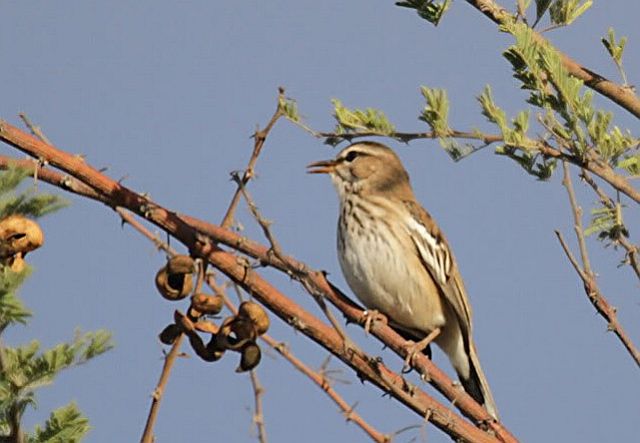 © leachy
© leachy
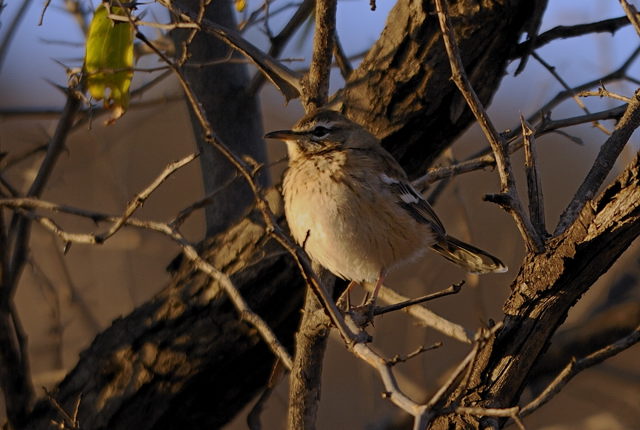 © Dewi
© Dewi
 © Dewi
© Dewi
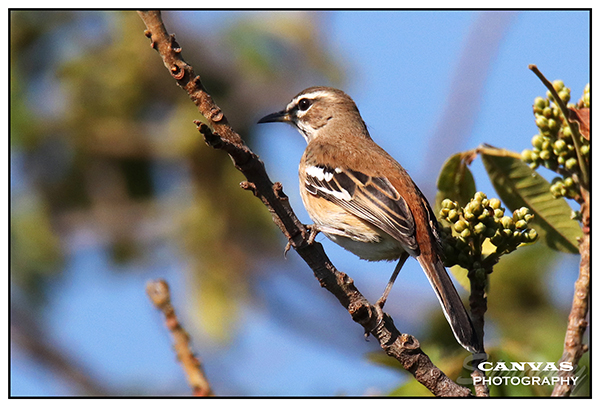 © Sprocky
© Sprocky
Grietjie Private Reserve, Limpopo
Links:
Species text Sabap1
Sabap2: http://sabap2.adu.org.za/species_info.p ... #menu_left
 © Flutterby
© FlutterbyiMfolozi
 © leachy
© leachy © Dewi
© Dewi © Dewi
© DewiGrietjie Private Reserve, Limpopo
Links:
Species text Sabap1
Sabap2: http://sabap2.adu.org.za/species_info.p ... #menu_left


